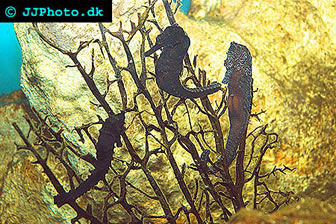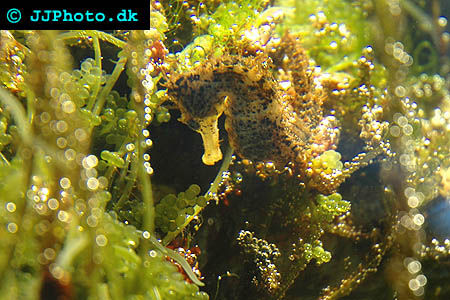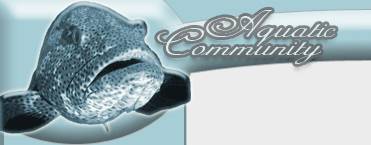Common Seahorse
Hippocampus kuda

Hippocampus kuda is known under many different common names in English, including Common Seahorse, Spotted Seahorse, Smooth Seahorse, Yellow Seahorse, Estuary Seahorse, Oceanic Seahorse, and Red Oceanic Seahorse.
In the past, virtually any unidentified seahorse species was called Hippocampus kuda and this can of course lead to misunderstandings. A lot of the seahorses imported from Asia are still sold as Hippocampus kuda, even when they are not.
Earlier, Hippocampus horai, Hippocampus novaehebudorum, Hippocampus taeniops and Hippocampus raji were considered separate species, but they are know regarded as synonyms of Hippocampus kuda.
Conservational status
Hippocampus kuda is listed as Vulnerable (VU) on the IUCN Red List of Threatened Species and the international trade is monitored through a licensing system (CITES II, since 5.15.04).
The main threats against Hippocampus kuda is habitat degradation and intentional and incidental capture. It is a very popular aquarium fish and is it also used in traditional Chinese medicine. In addition to this, the species is used to make souvenirs for tourists.
The main exporters of Common Seahorse are India, Thailand, Vietnam and the Philippines, but over 50 nations are involved in buying and selling the species on the international market.
The Common Seahorse has been successfully bred in captivity, but wild-caught specimens are still very common in the aquarium trade. Specimens imported from Asia are almost always wild caught, but there are of course exceptions.
Geographical range, habitat and habits
The Common Seahorse is found in the Indo-Pacific, from the Indian Ocean to the north-western, western central, and eastern central areas of the Pacific Ocean. It is present in both marine and brackish environments and can be encountered from the surface down to a depth of 68 meters / 223 feet. Common seahorses are however most commonly found in the upper 8 meters / 26 feet of the water column.
This species can be found in mangroves, coastal bays, harbours, lagoons, marine algae areas of estuaries, seagrass beds, seaward reefs, near steep mud slopes, and over rocky littoral zones. Some specimens live out in the open water instead (up to 20 km / 13 miles from shore) where they stay attached to drifting Sargassum, while other swim into rivers with brackish water.
The Common Seahorse is not a powerful swimmer and it will spend most of its time hanging on to something with its tail, e.g. corals or sea grass. They are night-active and will normally live alone or in pairs. Once a pair has picked a home range, both fishes will stay there until one of them dies or their habitat is destroyed.
Size and appearance
The largest scientifically measured Common Seahorse was 30 cm / 11.8 in from the top of the coronet to the tip of the outstretched tail. Most specimens will however be around 7-17 cm / 3-7 in as adults.
This species is a smooth seahorse with low spines. The colour of the body is typically black, brown, creamy, yellow, orange-yellow or red and the exact colouration can change depending on numerous factors, such as surrounding environment, mood and diet. It is common for the Common Seahorse to be decorated with reddish brown circles over its entire body.
Just like all the other seahorses, the seahorse is without pelvic and caudal fins and its body is protected by ring-formed bony plates instead of scales. The skin is stretched over these bony plates.
In most seahorses, spines are found along the body, but the Common Seahorse will instead display rounded bumps. This species is also equipped with an unusually thick snout and a deep head.
Common Seahorse care
Provided that you know how to keep the water quality up, one pair can be housed in a 25 gallon / 100 L aquarium. If you want to keep two pairs, a well decorated 35 gallon / 130 L aquarium is normally enough. The aquarium should be at least 18 in / 45 cm tall.
The recommended water temperature when keeping Common Seahorse is 72-79° F / 24°-26° C. The specific gravity should be around 1.021 and the pH-value close to 8.2.

Feeding Common Seahorse
The Common seahorse is an ambush predator and you should be prepared to give it live, moving food in the aquarium. Since it moves to slowly to chase after prey, it will use its specialized snout to suck in suitable prey. In the wild, the bulk of its diet is made up by small crustaceans, zooplankton, larvae and worms and it should be provided with a similar diet in the aquarium.
Breeding Common Seahorse
The Common Seahorse is an egg-laying species and the male will keep the offspring inside a brooding pouch located under his tail.
Just like many other seahorses, the Common Seahorse is a monogamous species. Mating will typically take place between October and January but can occur year round. Breeding may occur every 20-28 days and, as far as we know, this species can have up to three births per year. The female can place a new brood in her partner's pouch as soon as he has released the old brood.
The couple will carry out a courtship ritual where the male will dance around the female while changing his colour pattern and producing clicking sounds by tossing his head. During the next step, the pair will entwine their tails and float over the bottom. After a while, they will face each other belly-to-belly and the female will use her ovipositor to deposit her eggs inside the male's brooding pouch. The brood size will depend on the age and size of the parents and can vary from only 10 eggs to over 1400. The average brood size is 200 eggs.
Even after the male has become pregnant, the pair will continue to carry out their courtship ritual, but a modified version of it. They will greet each other each morning by dancing, changing colours and interweave their tails.
The male will carry the offspring in his pouch for 20-28 days and secrete a placental-like fluid inside the pouch to provide them with nutrients. This fluid will also serve to remove waste products and keep the oxygen level up. As the offspring becomes more and more developed, the chemical composition of the fluid will change and become more and more like seawater to acclimatize them to life outside the pouch.
The male will typically release the offspring during a full moon. The labour is an arduous task because the male is forced to continuously pump and thrust, sometimes for several hours, until all fry are born.
The Common Seahorse has been successfully bred in captivity. If you manage to get your pair to breed in your aquarium, you can feed the emerging fry newly hatched brine from day one. They are not released from the pouch until they are large enough to feed on their own without the aid of their parents. Newborn Common Seahorses are usually around 7 mm / 0.28 in.
Seahorse Articles:
Sea horses in Aquarium - An article about how to keep sea horses in aquariums.Lined Seahorse – A guide to keeping Hippocampus erectus
Long Snout Seahorse – A guide to keeping Hippocampus reidi
